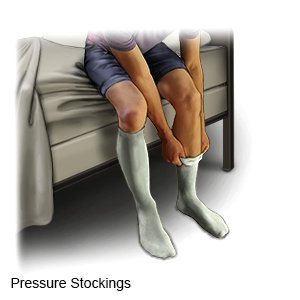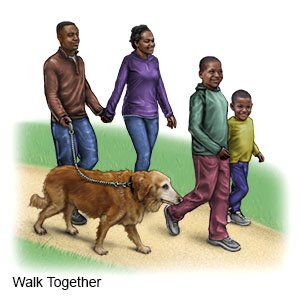Vein Stripping
Medically reviewed by Drugs.com. Last updated on Apr 6, 2025.
Vein stripping is surgery to remove varicose veins. Varicose veins are large, twisted veins that bulge out under your skin.
 |
DISCHARGE INSTRUCTIONS:
Call your local emergency number (911 in the US) if:
- You feel lightheaded, short of breath, and have chest pain.
- You cough up blood.
Seek care immediately if:
- Your leg feels warm, tender, and painful. It may look swollen and red.
- Blood soaks through your bandage.
- Your stitches come apart.
- You have trouble moving your leg or foot.
Call your doctor if:
- You have a fever or chills.
- Your incision is red, swollen, or draining pus.
- You have numbness in your legs or feet that does not go away.
- You have questions or concerns about your condition or care.
Drugs used to treat this and similar conditions
Xarelto
Xarelto (rivaroxaban) is a factor Xa inhibitor used to reduce the risk of blood clots and stroke in ...
Eliquis
Eliquis (apixaban) is used to reduce the risk of stroke and systemic embolism in patients with ...
Omvoh
Omvoh is used to treat moderate to severe ulcerative colitis or Crohn's disease in adults. This ...
Lasix
Lasix is a loop diuretic used to treat fluid retention from heart, liver, or kidney conditions, and ...
Tylenol
Tylenol is a pain reliever and a fever reducer used to treat many conditions such as headaches ...
Hydrocodone
Hydrocodone (Hysingla ER and Zohydro ER) is used for around-the-clock treatment of severe pain ...
Oxycodone
Oxycodone is an opioid analgesic used to treat moderate to severe pain; it has a high potential for ...
Lovenox
Lovenox is used to prevent deep vein thrombosis (DVT) which can lead to blood clots in the lungs ...
Acetaminophen/hydrocodone
The combination of hydrocodone and acetaminophen is used to relieve moderate to severe pain ...
Medicines:
You may need any of the following:
- Prescription pain medicine may be given. Ask your healthcare provider how to take this medicine safely. Some prescription pain medicines contain acetaminophen. Do not take other medicines that contain acetaminophen without talking to your healthcare provider. Too much acetaminophen may cause liver damage. Prescription pain medicine may cause constipation. Ask your healthcare provider how to prevent or treat constipation.
- NSAIDs , such as ibuprofen, help decrease swelling, pain, and fever. NSAIDs can cause stomach bleeding or kidney problems in certain people. If you take blood thinner medicine, always ask your healthcare provider if NSAIDs are safe for you. Always read the medicine label and follow directions.
- Take your medicine as directed. Contact your healthcare provider if you think your medicine is not helping or if you have side effects. Tell your provider if you are allergic to any medicine. Keep a list of the medicines, vitamins, and herbs you take. Include the amounts, and when and why you take them. Bring the list or the pill bottles to follow-up visits. Carry your medicine list with you in case of an emergency.
Care for your surgery area as directed:
Keep the area clean and dry. When you are allowed to bathe, carefully wash the area with soap and water. Dry the area and put on new, clean bandages as directed. Change your bandages when they get wet or dirty.
Self-care:
- Wear pressure stockings if directed. You may need to wear pressure stockings for several weeks to months after surgery. The stockings are tight and put pressure on your legs. This improves blood flow, prevents clots, and helps you recover from surgery.

- Walk often if you can. Even 10 minutes of light walking will help improve blood flow and prevent blood clots. Ask your provider about the best exercise plan for you.

- Do not sit or stand for long periods of time. This can cause the blood to collect in your legs and damage your veins. Bend or rotate your ankles several times every hour.
- Do not dangle your legs or cross your legs when you sit. This decreases blood flow to your feet and can cause blockage or swelling in your legs.
- Elevate your legs about 30 degrees and support your entire leg. Do this several times a day or as directed. Prop the end of your bed up slightly to elevate your legs while you sleep. This will help blood to flow back to your heart.

- Do not wear tight clothing or shoes. Do not wear high-heeled shoes. Do not wear clothes that are tight around the waist, knees, or ankles.
- Maintain a healthy weight. Extra body weight can increase your risk for the varicose veins to return. Ask your provider what a healthy weight is for you. Your provider can help you create a weight loss plan, if needed.
Follow up with your doctor as directed:
You will need to return to have your incision checked and drain or stitches removed. You may need more blood tests or another ultrasound to check blood flow in your legs. Write down your questions so you remember to ask them during your visits.
© Copyright Merative 2025 Information is for End User's use only and may not be sold, redistributed or otherwise used for commercial purposes.
The above information is an educational aid only. It is not intended as medical advice for individual conditions or treatments. Talk to your doctor, nurse or pharmacist before following any medical regimen to see if it is safe and effective for you.
Further information
Always consult your healthcare provider to ensure the information displayed on this page applies to your personal circumstances.
